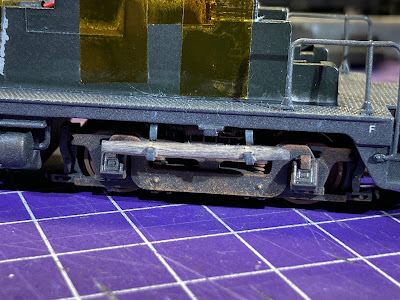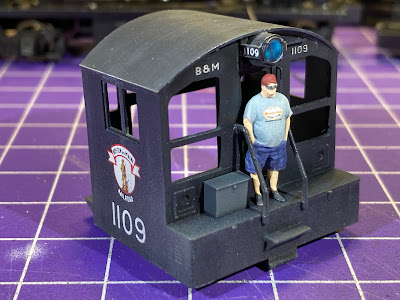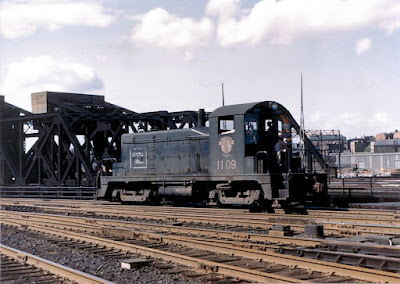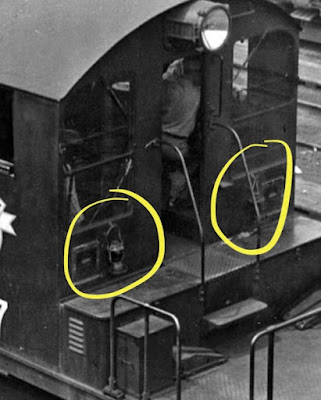Wednesday, January 25, 2023
Wednesday, January 11, 2023
Monday, January 9, 2023
Modeling Monday: B&M SW1 #1109 is Finished!
After adding the final details (except for the lantern, which is on its way), I just had some final weathering to do.
Here are the steps I took:
- Applied an overall coat of semigloss.
- Using prototype photos as a guide, added major oil spills using dots of lamp black oil paint, "pulled down" with a brush dampened in mineral spirits.
- Added many minor spills and details using Tamiya Black Panel Line Accent Color (a.k.a. "Taco Sauce").
- Applied some burnt umber gouache "rust" to the handrails, grabs, cooler/lunchbox, and couplers.
- Waited 3 days for everything to dry thoroughly (mostly cuz I couldn't get to it again for that long - YMMV).
- Sealed the whole engine with a coat of Dulcote
- Rubbed the side of a pencil along the handrails, grabs, door handles, hood railings - anywhere crew members would be handling metal. Oh - don't forget the top edge of the lunchbox, step edges, top edges/corners of the truck sideframes, etc.
- "Freshened up" some of the oil spills with AK "Engine Oil" and Mig "Fresh Engine Oil" applied with a small brush.
- Applied black Pan Pastel to tone down the brass bell (no pun intended), more to the top of the stack, and along the top of the hood and cab roof.
 |
| I think the Brotherhood may have something to say about my crew "accommodation" |
- First and foremost, Philip Taylor who I'd met through the A Modeler's Life (AML) podcast and who - when he heard I was looking for an SW1 model - sent me a brand new Walthers engine (and even the "right" 2nd run one!). Anyone that's been following this project knows that it's provide many, many hours of enjoyment.
- The Walthers model was painted for the PRR, and to model the 1109 in the livery I wanted, I needed decals. Dave Owens and Tom Murray came through with what I needed.
- A quick search of the internet pointed me to "The Model Railroader's Guide to B&M/MEC Diesel Paint Schemes" which not only educated me on all the different liveries, but is a wealth of information and photos.
- David Hutchinson - who happens to be the moderator/owner of that FB group - gets a HUGE thank you for not only providing many prototype photos of the 1109 right off the bat, but he also contributed some critical detail parts and additional decals. I couldn't have finished the detailing and lettering without his help.
- Hunter Hughson and Seth Lakin provided some fantastic articles and prototype information that was priceless early on and helped me figure out what details I was going to need.
- Speaking of details, thanks goes to Rick Abramson and John Kasey for additional details I'd forgotten.
- And finally, this project could not have been truly finished without a good "finish" - and by that, I mean weathering. Other than a quick dusting with chalks and dulcote, I'd never truly weathered a locomotive before - especially not based on prototype photos. But Ralph Renzetti (a.k.a. "The Mudfather"), someone else I met through the AML, offered to help - being my "training wheels" and guiding me through the process. No small feat considering he lives in Canada(!) We spent many hours "together" in my paint room, with him watching over my shoulder via FB Messenger Video and my iPad. One of the biggest challenges in weathering - for me at least - is knowing what materials to use, when to use them, and what they're (in)compatible with. Knowing Ralph was there to keep me from totally screwing up such a nice loco gave me the confidence to go for it. The final finish is the direct result of his helpful guidance..
But as the project evolved, and more folks became involved, the 1109 became so much more - and I don't mind saying that it's become my favorite diesel. And I've definitely learned many new skills that I'm looking forward to using on future projects!
Saturday, January 7, 2023
Adding Final Details to the 1109
After finishing the initial weathering, I decided to go ahead and add some B&M-specific details: lunchbox/cooler, rerailers, a hook for a lantern, and a poling pole.
 |
| You can make out the rerailer beneath the cab (and there's one on the other side as well) and the poling pole under the walkway above the engineer's side front truck. |
 |
| The cooler/lunchbox is located on the back of the cab to the left of the cab door. |
 |
| Though not the 1109, this photo shows where the B&M had some hooks to hang lanterns. |
First I got some rerailers (Precision Scale 31644) and drilled some holes for the hooks to go into...
I "painted" it with a black sharpie, but it'll be further weathered later (it's only dry fit in the photo above).
With the addition of these details, there's literally nothing else to add - except more weathering! Stay tuned next time for that . . .
Wednesday, January 4, 2023
Sunday, January 1, 2023
Happy New Year & B&M 1109: Initial Weathering
Since this is my first post of 2023, I want to wish you and yours a Very Happy New Year! Here's hoping you have a very safe, healthy, and productive year and that you're able to knock off your to-do/bucket list some things that have been lingering for a bit too long.
One of the things that's been lingering a bit long here at The Valley Local is the B&M SW1 - though I admit I've been having a blast working on it and am simultaneously reluctant to finish it and chompin' at the bit to get it on the layout and into revenue service!
To that end, it's been a VERY productive - what - 12 days?? Despite having Christmas and New Years happening since we got back from Cape Cod on the 18th, I've just about completed this loco . . . but I'm getting a bit ahead of myself . . .
The last time I posted about it, I'd realized that I'd forgotten to add two final decals on each side sill. With the decaling/lettering now finished, I'm at the point where I usually stop. Or at least that's where I left the DEY-5. But the 1109 is "just" a "leased unit" for the Valley Line, so no risk - no pressure - no reason not to try out weathering(!)
Thankfully, my friend Ralph (who also happens to be a professional weather-er - a.k.a. "The Mudfather") was willing to be my "training wheels" and mentor me through the process. Follow along as I try and convey a few of the techniques he shared - and which, to my surprise, I discovered are not only relatively easy, but yield fantastic results!
Truck Sideframes
For the sideframes, Ralph had me try daubing on gouache with a sponge.
At this point, it looked so great to me I was VERY tempted to call it "done," put it back together (including windows & couplers) and put it into service. But the research prompted by my trip down the rabbit hole (aided and abetted heavily by David Hutchinson and his excellent Facebook Group on B&M/MEC paint schemes) produced this photo:
And as if that wasn't enough, the B&M also typically had some sort of cooler/lunch box on the back deck, along with hooks to hold lanterns:
But I'd come this far with this engine, so I figured out a way to add these additional details as well. Stay tuned next time for how I went about it . . .























































